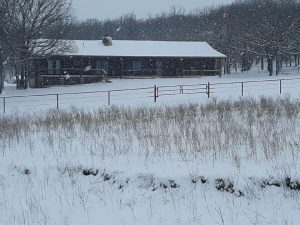
Peg and I recently moved from Posey County in southwestern Indiana to Osage County in northeastern Oklahoma. The acculturalization for me was fairly seamless as I was born in Pawhuska, which is the county seat of The Osage. As for Peg, she was born in Schenectady, New York and has lived north of the Mason-Dixon Line and east of the Mississippi River her whole life. She is what we of the Oklahoma persuasion would generally classify as a “Yankee”. For Peg, the move from the land of corn, soybeans and concrete has been, well, let’s just say more interesting. And our log cabin out on the prairie thirty miles from the nearest Walmart occasionally poses new challenges for her. Oh, we do have a Dollar General about five miles away, but there’s one of those everywhere so that does not assuage Peg’s concerns.
As Peg becomes accustomed to being called “Ma’am” and getting to frequently use her high beam headlights on the uncrowded highways she is often confronted with the ambiance of a life lived among creatures she used to assume lived in zoos or within the confines of the Tallgrass Prairie Nature Preserve or the 3,700 acres of the marvelous Woolaroc Museum with bison and other animals only 7 miles from our cabin. Imagine her reactions when she began to encounter hawks, eagles, deer, wild turkeys, cattle, armadillos, scorpions, coyotes, opossums and raccoons right outside our door. Actually she has habituated quite well to most of Mother Nature’s creatures even when they pushed their way into our personal space. Unfortunately, our most recent visitors have been a family of skunks. That’s right. What the French zoologist Charles Lucien Bonaparte (1803-1857) classified as Mephitidae, which means stink.
When Pepé Le Pew was cavorting on the cartoon movie screen in search of love while spouting off in a French accent, the skunk came across as cute and lovable. However, when our own skunk family took up residence under our cabin and spent their nights defending their territory by spraying copious volumes of malodorous ink at the opossums challenging for the same space, Peg called for Terminix. The nearest office was in Tulsa fifty miles away.
Now we have live traps baited with some kind of cat food and cement poured into every cranny around the base of our cabin. Each night the skunks find a new way to burrow, chew or claw their way back under our home. Gentle Reader, please imagine city girl Peg’s reaction to the wafting of odiferous waves of stench up through the floor and into her rugs and clothing. That’s right. It ain’t pleasant.
On the positive side we probably do not need to worry about any visitors wanting to stay even the traditional 3-day limit. As for Peg, she now understands why I bought a shotgun when we decided to move west.
